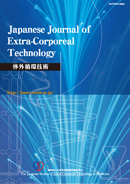All issues

Volume 41 (2014)
- Issue 4 Pages 441-
- Issue 2 Pages 123-
- Issue 1 Pages 1-
Volume 41, Issue 4
Displaying 1-2 of 2 articles from this issue
- |<
- <
- 1
- >
- >|
Original Articles
-
Atsushi Nakamura2014 Volume 41 Issue 4 Pages 441-450
Published: 2014
Released on J-STAGE: December 27, 2014
JOURNAL FREE ACCESSGaseous microemboli remain a concern during cardiac surgery under a cardiopulmonary bypass(CPB). We therefore measured basic changes in microbubbles within a CPB circuit to experimentally determine the performance of the bubble trap. Difficulties with controlling air bubble size were overcome by designing a novel bubble generator that produces bubble groups of arbitrary sizes. We then measured changes in the size of the bubbles in a tube(inside diameter, 9.5mm; length, 165cm). The generator produces bubbles of hydrogen and oxygen by electrolyzing a liquid that flows through the CPB circuit. We examined the difference between normal air bubbles(AB)and bubbles generated by electrolysis(EB). We then assessed changes in the size of the air bubbles produced by EB, and investigated the internal circuit pressure and temperature. The size of both EB and AB decreased in the tube and they behaved in a similar manner. The decrease in size correlated with the initial size of the air bubble and the reduction rate was faster for larger bubbles. Whereas temperature(25-38°C)minimally affected the bubble reduction rate, internal circuit pressure significantly affected the diameter of the air bubbles. We concluded that the experimental design was appropriate for evaluating changes in the bubble diameter. To design a bubble trap for the CPB circuit, parameters such as pressure, timing(blood path length)of the bubbles, and the circuit itself need to be considered. In addition, the bubbles produced by electrolysis were useful to assess the performance of the bubble trap.View full abstractDownload PDF (1174K) -
Yugo Nagae, Koichi Kashiwa, Osamu Kinoshita, Minoru Ono, Yutaka Matsuy ...2014 Volume 41 Issue 4 Pages 451-459
Published: 2014
Released on J-STAGE: December 27, 2014
JOURNAL FREE ACCESSIn Japan, clinical data of patients who receive a mechanical circulatory support device(MCSD)are recorded in the Japanese Registry for Mechanically Assisted Circulatory Support(J-MACS)by healthcare providers. We investigated whether J-MACS is accepted among clinicians who work for accredited centers and manufacturers and sellers of MCSDs and whether their workload during the registration process is high using a questionnaire form. We also analyzed the access logs for J-MACS at a single accredited center to clarify the conditions of its registration process.Thirty-one clinicians from 15 centers and eight people from three companies responded to and filled the questionnaire form. Half of them answered that clinical work was frequently interrupted by this registration process. Of the respondents, 26% believed that J-MACS could be useful to improve the management of patients supported by MSCDs. Twelve(31%)people admitted that publication of the collected data should be one of the keys to keep them motivated. Many respondents felt that each question and the timings of follow-up visit forms were acceptable. However, at the same time, they believed that it was potentially useful to analyze the registry data to deliver clinically constructive suggestions rather than to drastically alter the registry items into domestic ones. According to analysis of access logs, duration of a single log-in activity was less than 10 min in 44% of all accesses.The excessive frequency of the registration process, not the time spent for a single log-in process, seemed to be an imposed burden on healthcare providers who contribute to the J-MACS registry.View full abstractDownload PDF (1156K)
- |<
- <
- 1
- >
- >|